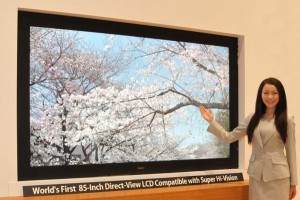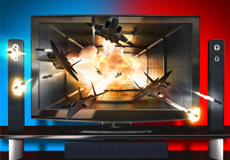
Sharp announced it has built the first 85-inch LCD panel with resolution it claims is 16 times that of current HDTV panels. The prototype was developed for Super Hi-Vision, a next-generation television system being developed primarily by Japan Broadcasting Corporation, NHK (Nippon Hoso Kyokai). Super Hi-Vision expects to provide four times as much detail horizontally and vertically (7,680 by 4,320 pixels) than today’s HDTV images.
 According to Network World, the first public trials of Super Hi-Vision are expected to begin around 2020 (although Engadget reports there is a possibility of early demonstrations taking place during the 2012 Olympics). Each frame of a Super Hi-Vision image is equivalent to a 33-megapixel picture; therefore, as Network World points out: “…highly complex cameras, mixing and switching systems, and recorders and transmission equipment need to be made to handle the huge bandwidth of the video image.” Sharp’s prototype is the next step toward the realization of the next-gen system.
According to Network World, the first public trials of Super Hi-Vision are expected to begin around 2020 (although Engadget reports there is a possibility of early demonstrations taking place during the 2012 Olympics). Each frame of a Super Hi-Vision image is equivalent to a 33-megapixel picture; therefore, as Network World points out: “…highly complex cameras, mixing and switching systems, and recorders and transmission equipment need to be made to handle the huge bandwidth of the video image.” Sharp’s prototype is the next step toward the realization of the next-gen system.
Sharp’s 85-inch LCD, which was not formally demonstrated in Los Angeles at SID Display Week 2011, will be unveiled to the public for the first time later this month at NHK’s Science & Technology Research Laboratories in Tokyo.
Related Network World article: “Sharp develops super high-def screen for future TV” (5/18/11)
Related Sharp press release: “Sharp and NHK Successfully Develop 85-Inch Direct-View LCD Compatible with Super Hi-Vision, a World First” (5/19/11)
By
Rob ScottMarch 29, 2011
Mitsubishi has announced that it is exiting the LCD TV market this year to focus on its DLP rear projection business. The company is the only maker of rear projection TVs sold in the US.
HD Guru explains that Mitsubishi made an early transition from big screen CRT models to lamp driven microdisplay sets. As the industry moved to flat panels, Mitsubishi opted to rely on outside vendors for its LCDs.
Mitsubishi currently offers 2010 models from 60-82-inch screen sizes, all with 3D capability. According to HD Guru: “Rear projection provides viewers with the biggest HDTV screens for the lowest prices in the industry, starting at under $850 for the 60-inch model widescreen 1080p HDTV and under $1200 for a 73-inch.” As a means of comparison, a Samsung 65-inch 1080p LED HDTV is presently offered at over $4000.
Mitsubishi 2011 rear projector models will be offered in sizes 73-inches and above. At January’s CES, the company announced a 92-inch model to ship later this year.


